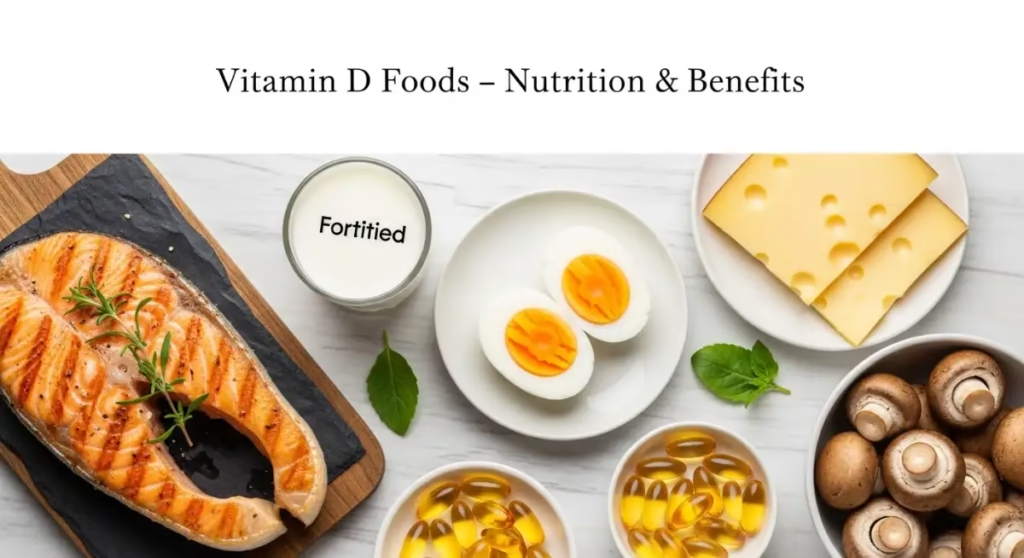Introduction: Why Vitamin D Foods Matter Today
In today’s fast-paced world, where many people spend more time indoors than outdoors, vitamin D deficiency is becoming increasingly common. Known as the “sunshine vitamin”, vitamin D is essential for strong bones, a healthy immune system, and overall energy levels.
But what happens when sunlight exposure is limited? That’s where vitamin D foods come in.
This article will guide you through:
- The best natural food sources of vitamin D
- Their health benefits
- Creative ways to add them to your diet
So, if you’ve ever wondered “Which foods are rich in vitamin D?”—this guide is for you.
What is Vitamin D?
Vitamin D is a fat-soluble vitamin that acts more like a hormone in the body. It plays a key role in:
- Absorbing calcium and phosphorus
- Maintaining healthy bones and teeth
- Supporting the immune system
- Regulating mood and reducing the risk of depression
There are two main types of vitamin D:
- Vitamin D2 (ergocalciferol): Found in plant-based sources.
- Vitamin D3 (cholecalciferol): Found in animal-based foods and produced in the skin when exposed to sunlight.
Why Do We Need Vitamin D Foods?
Not everyone can get enough vitamin D from sunlight due to:
- Indoor lifestyles
- Use of sunscreen
- Pollution and cloudy climates
- Darker skin tones (which produce less vitamin D naturally)
👉 That’s why including vitamin D foods in your diet is crucial for overall wellness.
Top Vitamin D Foods You Should Add to Your Diet
Here’s a comprehensive list of the best foods rich in vitamin D:
1. Fatty Fish
- Examples: Salmon, mackerel, sardines, tuna, herring
- Why: Among the richest natural sources of vitamin D.
- How to Use: Grilled salmon, tuna sandwiches, or sardine salad.
2. Cod Liver Oil
- A traditional supplement that provides vitamin D, omega-3s, and vitamin A.
- Just one teaspoon can meet more than 100% of daily vitamin D needs.
3. Egg Yolks
- Contain small amounts of vitamin D.
- Tip: Choose eggs from pasture-raised or free-range hens for higher levels.
4. Fortified Foods
Since natural sources are limited, many foods are fortified with vitamin D:
- Milk (dairy & plant-based alternatives like soy/almond milk)
- Breakfast cereals
- Orange juice
- Yogurt
5. Mushrooms (Sun-Exposed)
- Portobello, maitake, and shiitake mushrooms can naturally produce vitamin D when exposed to sunlight.
- A great vegan-friendly source.
6. Cheese
- Certain types like cheddar and Swiss contain small amounts of vitamin D.
- Works well as a snack or salad topping.
7. Beef Liver
- A nutrient-dense food with vitamin D, iron, and vitamin A.
- Best for people who prefer organ meats.
Nutritional Table of Vitamin D Foods
| Food Source | Vitamin D (IU per serving) | Serving Size | Notes |
|---|---|---|---|
| Salmon (wild) | 600–1000 IU | 100 g | Best natural source |
| Cod Liver Oil | 450 IU | 1 tsp | Also rich in omega-3s |
| Egg Yolks | 40 IU | 1 large egg | Higher in free-range eggs |
| Fortified Milk | 120 IU | 1 cup | Includes plant-based milks |
| Mushrooms (UV-exposed) | 150–200 IU | 100 g | Vegan-friendly option |
| Beef Liver | 50 IU | 100 g | Nutrient-dense, rich in iron |
Health Benefits
1. Stronger Bones and Teeth
Vitamin D helps the body absorb calcium, preventing osteoporosis and fractures.
2. Immune System Boost
A strong defense against colds, flu, and infections.
3. Mood and Mental Health
Studies link low vitamin D with seasonal depression (SAD). Adequate intake supports brain health.
4. Supports Heart Health
Helps regulate blood pressure and reduces cardiovascular risks.
5. Muscle Function
Vital for strength, coordination, and recovery after workouts.
Vitamin D Foods in Trending Diets
- Keto Diet: Salmon, eggs, and cheese fit perfectly.
- Vegan Diet: Mushrooms and fortified plant milks are great picks.
- Mediterranean Diet: Fatty fish and olive oil-rich recipes enhance absorption.
- Gluten-Free Diet: Fortified gluten-free cereals and juices work well.
Festival & Seasonal Angle: Why Vitamin D Foods Trend in Winter
In colder months, when sunlight is scarce, vitamin D deficiency becomes a seasonal health concern.
That’s why during winter or festive seasons, health-conscious people search for:
- “Best foods for vitamin D in winter”
- “Festive recipes with vitamin D-rich ingredients”
Examples:
- Christmas: Smoked salmon dishes
- Navratri fasting: Mushroom and spinach stir fry
- Diwali snacks: Egg-based sweets with added nutrition
This makes vitamin D foods an evergreen + trending topic for Google Discover.
Expert Tips for Better Vitamin D Absorption
- Pair vitamin D foods with healthy fats (olive oil, nuts, avocado).
- Spend at least 10–20 minutes in sunlight daily if possible.
- Avoid overcooking fish and eggs, as it reduces vitamin D content.
- Consider supplements only after consulting a doctor.
Possible Risks
While deficiency is common, too much vitamin D can cause:
- Nausea and vomiting
- Kidney problems
- High calcium levels
✔️ Stick to recommended daily intake:
- 600 IU (15 mcg) for adults
- 800 IU (20 mcg) for older adults (70+)
Conclusion
This foods are a lifeline for strong bones, immunity, and overall health. Since sunlight isn’t always enough, adding natural and fortified sources like salmon, eggs, mushrooms, and fortified milk to your diet ensures balance.
If you want to protect your bones, boost your mood, and stay healthy year-round, make vitamin D foods a permanent part of your plate.
FAQs
Q1. What is the richest food source of vitamin D?
Fatty fish like salmon and mackerel.
Q2. Can vegetarians get enough vitamin D?
Yes, from mushrooms and fortified foods.
Q3. Are vitamin D supplements better than foods?
Foods are natural and safe, but supplements may be needed if deficiency is severe.
Q4. How much vitamin D do I need daily?
Most adults need 600–800 IU daily.
Q5. Can I get vitamin D from the sun only?
Yes, but it depends on skin tone, location, and lifestyle—so foods are still essential.







